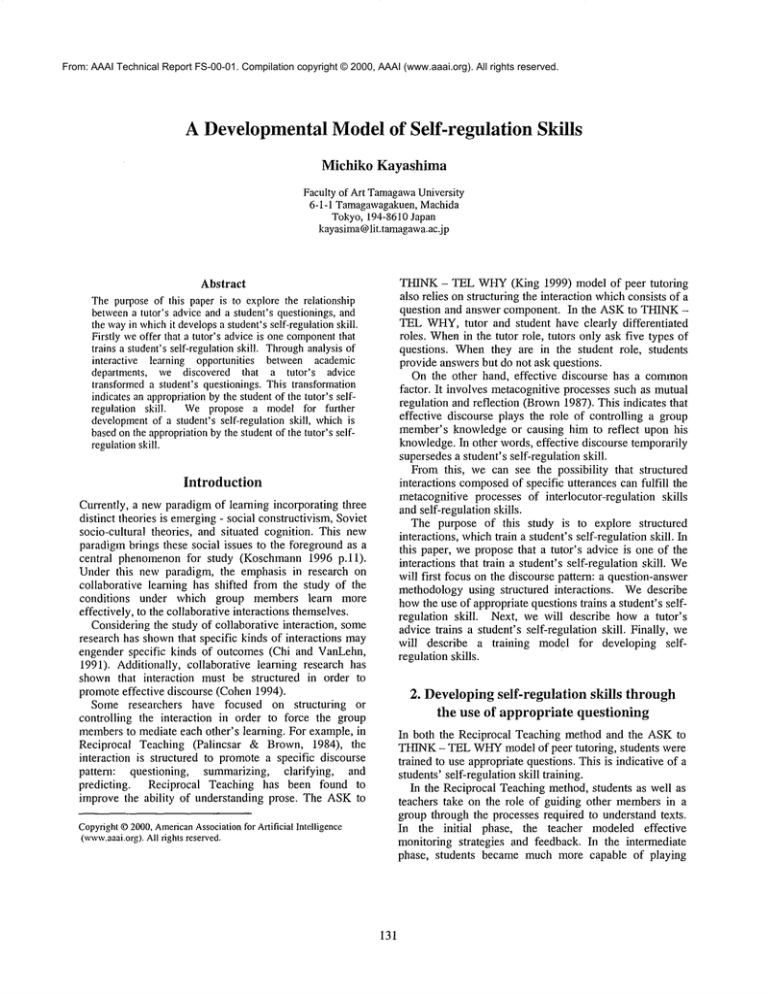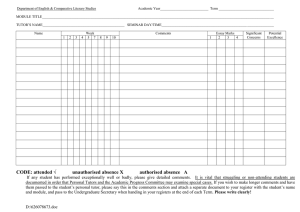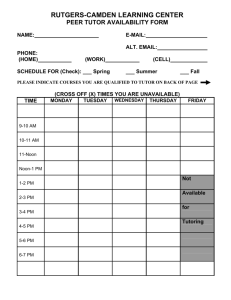
From: AAAI Technical Report FS-00-01. Compilation copyright © 2000, AAAI (www.aaai.org). All rights reserved.
A DevelopmentalModelof Self-regulation Skills
Michiko Kayashima
Faculty of Art Tamagawa
University
6-1-1 Tamagawagakuen,Machida
Tokyo, 194-8610 Japan
kayasima@lit.tamagawa.ac.jp
THINK- TEL WHY(King 1999) model of peer tutoring
also relies on structuring the interaction whichconsists of a
question and answer component. In the ASKto THINKTEL WHY,tutor and student have clearly differentiated
roles. Whenin the tutor role, tutors only ask five types of
questions. When they are in the student role, students
provide answers but do not ask questions.
On the other hand, effective discourse has a common
factor. It involves metacognitive processes such as mutual
regulation and reflection (Brown 1987). This indicates that
effective discourse plays the role of controlling a group
member’s knowledge or causing him to reflect upon his
knowledge. In other words, effective discourse temporarily
supersedes a student’s self-regulation skill.
From this, we can see the possibility that structured
interactions composedof specific utterances can fulfill the
metacognitive processes of interlocutor-regulation
skills
and self-regulation skills.
The purpose of this study is to explore sttuctured
interactions, whichtrain a student’s self-regulation skill. In
this paper, we propose that a tutor’s advice is one of the
interactions that train a student’s self-regulation skill. We
will ftrst focus on the discourse pattern: a question-answer
methodology using structured interactions.
We describe
howthe use of appropriate questions trains a student’s selfregulation skill. Next, we will describe how a tutor’s
advice trains a student’s self-regulation skill. Finally, we
will describe a training model for developing selfregulation skills.
Abstract
The purpose of this paper is to explore the relationship
betweena tutor’s advice and a student’s questionings, and
the wayin whichit developsa student’s self-regulation skill.
Firstly weoffer that a tutor’s advice is one component
that
trains a student’s self-regulation skill. Throughanalysis of
interactive learning opportunities between academic
departments, we discovered that a tutor’s advice
transformed a student’s questionings. This transformation
indicates an appropriationby the student of the tutor’s selfregulation skill. We propose a model for further
developmentof a student’s self-regulation skill, whichis
based on the appropriationby the student of the tutor’s selfregulationskill.
Introduction
Currently, a new paradigm of learning incorporating three
distinct theories is emerging- social constructivism, Soviet
socio-cultural theories, and situated cognition. This new
paradigm brings these social issues to the foreground as a
central phenomenon for study (Koschmann 1996 pal).
Under this new paradigm, the emphasis in research on
collaborative learning has shifted from the study of the
conditions
under which group members learn more
effectively, to the collaborative interactions themselves.
Considering the study of collaborative interaction, some
research has shown that specific kinds of interactions may
engender specific kinds of outcomes (Chi and VanLehn,
1991). Additionally, collaborative learning research has
shown that interaction
must be structured in order to
promote effective discourse (Cohen 1994).
Some researchers
have focused on structuring
or
controlling the interaction in order to force the group
membersto mediate each other’s learning. For example, in
Reciprocal Teaching (Palincsar
& Brown, 1984), the
interaction is structured to promote a specific discourse
pattern:
questioning,
summarizing, clarifying,
and
predicting.
Reciprocal Teaching has been found to
improve the ability of understanding prose. The ASKto
2. Developing self-regulation skills through
the use of appropriate questioning
In both the Reciprocal Teaching method and the ASKto
THINK- TEL WHYmodel of peer tutoring, students were
trained to use appropriate questions. This is indicative of a
students’ self-regulation skill training.
In the Reciprocal Teaching method, students as well as
teachers take on the role of guiding other members in a
group through the processes required to understand texts.
In the initial
phase, the teacher modeled effective
monitoring strategies and feedback. In the intermediate
phase, students became much more capable of playing
Copyright
©2000,American
Associationfor Artificial Intelligence
(www.aaai.org).
All rights reserved.
131
their role as dialogue leader, and by the final phase they
provided sophisticated paraphrases of the text and asked
sophisticated questions (Brown 1987). One reason for this
effect is that the teacher introduced students to their role as
a dialogue leader through explicit instruction
about
appropriate strategic directives (Wertsch 1998).
In the ASK to THINK - TEL WHYmodel of peer
tutoring, the student whois in the tutor role also constructs
a more accurate student model through the student’s
feedback. And the tutor could select the appropriate
question on the basis of the student model. If the student’s
answer to the tutor’s question is incomplete, the tutor asks
another question. This methodology of training using
appropriate questions causes the tutor to construct a model
of the student’s knowledge and to control the student’s
acquisition, integration and organization of knowledge
through asking appropriate questions.
From these analyses, we can conclude the following.
¯ Through explicit instruction in appropriate questioning
technique as described in Reciprocal Teaching, the
group leader could be trained to see an interlocutors’
knowledge structure as an object of his cognition.
Also, this method implies that the teacher causes
students to mimicproper self-regulation skill.
¯ The students who are in the tutor role or group leader
role can construct a student’s knowledge model and
control his knowledge. This methodindicates that the
interlocutors’
knowledge structures would become
an object of the tutors’ cognition.
It should be emphasized that these processes indicate
that the tutor took the meta-level role for the student’s
cognition. In other words, the tutor’s ability to use
appropriate questioning indicates the [interlocutor]regulation skill. During a period of utilizing
this
[interlocutor]-regulation, a student gradually internalizes it
as a self-regulation skill. At this point the student’s selfregulation skill will be operative. This process is identical
to Vygotsky’s general genetic law of cultural development
theory (Vygotsky, 1978).
"Every function in the child’s developmentappears twice:
first, on the social level, andlater on the individual level;
first, betweenpeople (inter-psychological) and inside the
.child (intra-psychological)".
3. A Tutors’
advice
transforms
questionings prior to receiving a tutor’s advice were
different from questionings after receiving advice.
In the initial phase of the tutoring, all students asked
similar questions such as "What is a modem?"However,
tutor’s advice transformed some of the students’ questions
into a confirmation-question or another what-question. The
former students were asking for justification of their own
assumptions
that were based on an explanation
encountered in their reading. The latter students were
asking for information to integrate their understanding of
what they read. For example:
Confirrnation-questions:
"I supposethat all informationis representedas one or zero.
If so, is hiraganaor katakanarepresentedas oneor zero?"
What-questions:
"Let us knowmore information about it, for example, the
merits or the demeritsand so on."
3.1 A classification
of user’s questions
In order to account for this transformation of students’
questionings, we categorized the various questionings.
As there were many factors encountered in students’
questions, it was very difficult
to determine their
classification. Moore(1995) classified students’ followup questions according to previously given explanations
and corlmmnicative goals. As student’s questions are
spontaneous and random, we decided to follow her
classification. Our adaptation of this classification is
shownin the following table.
QUESTION
What?
Is it true?
What?
PREVIOUSLY
GIVEN ADVICE
None
Makeuncertain
things clear
Makeuncertain
things clear
COMMUNICATIVE
GOAL
Acquisition
Comprehension
Integration
Table I
As table 1 shows, the communicative goal of student’s
questions was changed. This transformation of the user’s
communicative goal leads us to consider the student’s
knowledge transformation.
The initial questions: Whatquestion (Goal: Acquisition) indicate that a student was only
cognizant of an unknownthing in the subject matter. Also
he did not regulate
his knowledge. However the
communicative goal of questions after receiving advice,
which is Comprehension or Integration, was changed. The
latter questions indicate the student’s attempt to regulate
their knowledge.
On the other hand, it is known that low ability
performers are deficient
in both knowledge and the
resources for controlling that knowledge. And knowledge
differences reflect processing differences. Poor learners are
student’s
questions
Now we are ready to consider our main problem. We
regard both Reciprocal Teaching and the ASK to THINKTELWHY
model of peer tutoring as an indirect training of
self-regulation
skills. In this section we will analyze
research of student’s spontaneous questionings and a
tutor’s advice. Wewill consider that a tutor’s appropriate
advice can directly train a student’s self-regulation skills.
We analyzed the interaction
between advisers and
students during tutoring sessions amongdifferent academic
departments.
And we observed that the students’
132
deficient in knowledgebecause of poor learning skills, in
particular, the self-regulation skill (Campione
1987).
Furthermore, there are manydegrees of self-regulation
skill but the distinction has not been madeas clear. And
conscious awareness and direction of thought rank lower
than self-correction and regulation that can proceed below
the level of consciousness(Brown1987).
From this, we can see that the transformation of
students’ spontaneous questions indicates how they
regulate their knowledgestructures. This transformationis
mainly because of the change from a spontaneous selfregulation skill to a higher-level self-regulation skill that
the tutor’s scaffold as a coachcauses students to engender
spontaneously.
4. A tutor’s
the transformation was triggered by the student’s
appropriationof a tutors’ advice. This claim is not newand
can be found in various studies (Rogoff 1991, Wertsch
1998).
The tutor’s advice indicates his monitoringand control:
i.e. howthe tutor monitored the student’s knowledge
structure, and how the student should regulate his
knowledgestructure if the roles werereversed.
What is important is whether students engage in
conscious cognition when they receive this advice
(Kayashima and Okamoto 1999b). This is important
because metacognitive experiences are most apt to occur
whenever one engages in conscious cognition (Flavell
1981). By engaging in conscious cognition, the student’s
knowledge structures can become an object of his
cognition. Somestudents, who engaged in conscious
cognition, were aware of their deficient monitoring and
then appropriated the tutor’s regulation itself. Others did
not appropriate it. Although the former student was
transformed,the latter was not transformedin the light of
questionings. The appropriation of a tutors’ regulation
might lead to modification of the student’s knowledge
structures, whichthen might transform his questioning. In
other words,the transformationof students’ questions does
not necessarily meanthat the student’s serf-regulation
skills have developed. However,the developmentof selfregulation skill requires the appropriationof a higher selfregulationskill.
advice trains students’ selfregulation skills
Here wewill describe howa tutor’s advice trains students’
self-regulation skills fromthe viewpointof the relationship
between advice and the transformation of students’
questionings. Beforedescribing this claim, we will analyze
the relationship between advice and the students’
transformedquestions.
4.1 Whatis advice?
There are three typical advice patterns in response to
students’ questionsin the initial phaseof tutoring.
5. The developmental model of self-regulation
skill
Advice#1: Youshouldbe morespecific whenyouask somebody
a question.
Advice#2: Youshould be morespecific whenyouask somebody
a question. Thereare explanationsabout CPU’sin magazines.
Pleaseread them.If youhavequestionsafter readingthem,I can
help you.
Advice#3: Youshould be morespecific whenyouask somebody
a question.If youmakethe things youdon’tknowclear, youwill
be successfulandwill enjoylearning.
Nowwe shall describe howa student appropriates a tutor’s
serf-regulationskill, using the followingdescription:
Monitoring: monitoring (Agent, Target, Level) (1)
Control:
control (Agent, Target, Level)
(2)
Here we describe howa learner (Agent) monitors his
own or another’s cognition (Target) through some
monitoring level (Level) as shown in (1) above.
Additionally a learner (Agent) controls his own
another’s cognition (Target) at somecontrol level (Level)
as shownin (2) above. The agent is a person whomonitors
or controls. The target is knowledgestructures that are
monitored by the Agent. The value of Agent or Target is
shownas T and L, in which’T’ refers to tutor and "L" to
learner. The value of Level is "Li" meaning that
monitoring level is i, and "L,+I" meansthat monitoring
level is higher than "L".
Wedescribe a learners’ questioningsand a tutors’ advice as
follows:
This advice is representative of a tutor’s own selfregulation skills, which are informed by the student’s
questionings and which regulate student’s cognitive
activities (Kayashimaand Okamoto1999a). This is made
clear when we see that all of the advising statements
include the same phrase: " Youshould be more specific
when you ask somebodya question." This phrase means
that students should performconscious cognition of their
knowledgestructures. In other words, this phrase gives
students insight into howa tutor regulates a student’s
knowledgestructures.
4.2 The relationship between advice and the
transformation of students’ questionings
Here we describe the relationship betweenthe advice and
the transformation of student’s questions. Weclaim that
Questioning: tell (Agent, Others, To do)
want (Agent, Others, To do)
Advice:
(3)
(4)
Wedescribe that a learner (Agent) asks a tutor (Others)
133
uestion as shown in (3) above, because a learners’
uestionings imply that they tell tutors their immediate
ntecedent cognitive actions (To do). As tutors (Agent)
’ant learners (Others) to engage in proper cognitive actions
Fo do), they advise. Therefore we describe advice as (4).
As students’ questions at the initial phase of the tutoring
:present their awareness of incomprehensible concepts, we
escribe them as (5). This monitoring level is .... , because
:udents were only cognizant of incomprehensible concepts.
he advice received from their initial questions represents
mt tutors want learners to regulate their knowledge
xuctures in the same way the tutor regulates learners’
nowledgestructures. It is a higher level than one that was
fitially
seen in their questionings.
We describe it
"L~"(i>0). This we also indicate as (6).
tell ( L, T, monitoring(L, L, Lo)
want ( T, L, control( T, L, Li )
In further work we intend to explore what advice
encourages a students’ appropriation of a tutor’s selfregulation skills, specifically,
what advice becomes the
object of conscious cognition. Solving this issue, we could
then utilize more effectively this model for training selfregulation skills.
References
Brown,A. 1987Metacognition,
ExecutiveControl, Self-regulation, and
Other MoreMysteriousMechanisms.
In Metacognition,Motivation,
and Understandhtg.F.E. Weinertand R. H. Kluwe,eds. 65-116.
Hillsdale, NewJersey:Lawrence
ErlbattmAssociatesPublishers.
Cahour,B. 1990Competence
Modellingin ConsultationDialogues.In
WorkWithDisplayUnits 89. L. BerlinguetandD. Berthelette, eds.
363-370.ElsevierSciencepublishersB.V.(North-Holland)
Chi, M.T.H.&VanLehn,K.A. 1991 The Content of Phisics SelfExplanations.Journalof the LearnhlgSciences1(1):69-105.
Cohen,E. G. 1994 Restructuring the Classroom: Conditions for
ProductiveSmallGroups.Reviewof EducationalResearchSpring
64(1):1-35.
(5)
(6)
Now,we describe how a learner appropriates a tutor’s self:gulation skill; especially regulation as follows. We
escribe that the learner appropriates the tutor’s regulation
<ill following a learner’s questioning and the subsequent
~tor’s advice as shown in (7) below. That is to say, the
:arner appropriates the tutor’s regulation skill: control (L,
, I~). It should be noted that "control (T, L, L0" is the same
"control (T, L, Li)" in "want (T, L, control (T, L, Li))",
bus the appropriation might engender the learner to modify
is knowledge structures.
The transformation
of his
nowledgestructure leads the learner to ask a question that
as a different comanunication goal from that of his initial
uestion. This is shownas (8) below.
tell ( L, T, monitoring(L,L, Li)
<-tell ( L, T, monitoring(L, L, Lo)
&want (T, L, control(T, L, L0
& control (T, L, L0
Campione,J. C. 1987. MetacognitiveComponents
of Instructional
Researchwith ProblemLearners.In Metacognition,Motivation,and
Understanding. F. E. Weinert and R. H. Kluweeds. 117-140.
Hillsdale, NewJersey: Lawrence
Erlbaum
Associates,Publishers.
Flavell, J.H. 1981 C%maitiveMonitoring. In Children
Oral
Comnnmication
Skills. W.P. Dickson,ed. 35-60.Academic
Press.
Kayashima,M- and T. Okamoto1999aReflective Thinking by the
OtherResponseis able to ProduceMonitoringIn Proceedingof EDMEDIA99
and ED-TELCOM99,
1803-1807. Association for the
Advancement
of Computing
in Education.
Kayashima,M. and T. Okamoto1999b. Awarenessof the Other
Metacognitionis the DiscerningFactor by WhichReflection Turns
into MonitoringIn Proceedings
of AIED99.
717-719.IOSPress.
King, A. 1999DiscoursePatterns for MediatingPeer Learning. In
CognitivePerspectiveson PeerLearnbtg.O’DonnellA.M.&King,A
eds. 87-115. Mahwah,
NewJersey: LawrenceErlbaumAssociates,
Publishers.
Koschmann,
T. 1996ParadigmShifts and Instructional Technology:In
An bzstruction, bl CSCL:Theory and Practice of an Emergbtg
Paradigm. Koschmann
ed. 1-23. Mahwah,NewJersey: Lawrence
Erlbaum
Associates,Publishers.
(8)
(5)
(6)
(7)
This modelof training self-regulation skill indicates that
learners use appropriate questions by the appropriation of
the student’s self-regulation skill. ITS systems should
advise a user on a level appropriate to a skilled adviser’s
self-regulation skill. Also, an ITS system could evaluate
through the user’s follow-up questions whether the user
adequately appropriates it.
Moore,J.D. 1995. Participating hi ExplanatoryDialogues.The MIT
Press
6. Conclusion
Palincsar, A. S. and A. Brown1984 Reciprocal Teaching of
Comprehension- Fostering and Comprehension- Monitoring
Activities.CognitiveandInstruction.1(2):117-175.
Wepropose a prototype model for training self-regulation
skills. This model is based on question-answer dialogue,
and is also based on the view of a user’s internalization of
another’s self-regulation skills as users appropriate them.
If we develop the model, we can create a new, effective
advice discourse and improve learning through changes in
a student’s self-regulation skills.
Rogoff,B. 1991Guidanceand Participation in Spatial Planning. In
Perspectiveson Socially SharedCognition.L.B.Resnick,J.M.Levin,
and S.D.Teasley,eds. 349-364,AmericanPsycholo~calAssociation,
Washington,DC
Vygotsky,L. A. 1978MhMbl Society: The Developmentof Higher
PsychologyProcesses.Cambridge,MA:HarvardUniversityPress
Wertsch,J. W.1998.MindAs Action.OxfordUniversityPress
134



